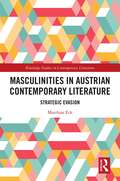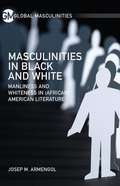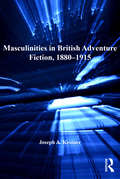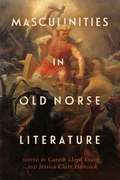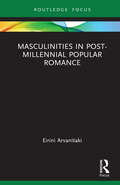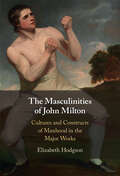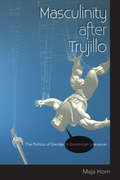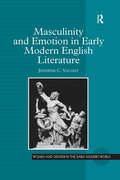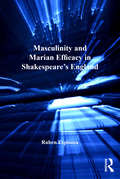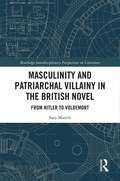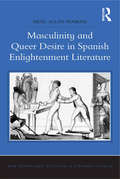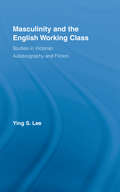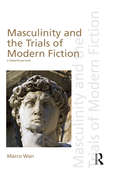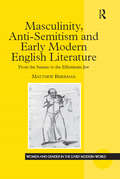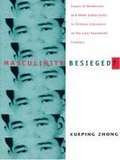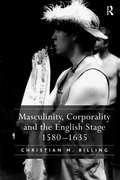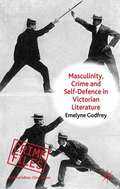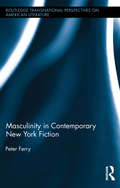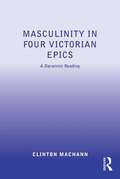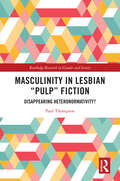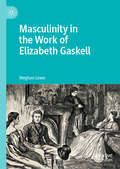- Table View
- List View
Masculinities and Representation: The Eroticized Male in Early Modern Italy and England
by Konrad EisenbichlerIn studies on premodern masculinities that have enriched scholarship in recent years, relatively little attention has been paid to the eroticizing of the male body. Masculinities and Representation seeks to fill this lacuna, illustrating how gender construction served to affirm but also diversify premodern masculinity. In so doing, this collection details how, as a social construct, masculinity was not a single concept, but a dynamic and intricate notion. Focusing on the premodern period, Masculinities and Representation reveals how heteronormative masculinity was affirmed, but also how it was challenged when the male body was eroticized in art, literature, and devotion, or when “masculine” norms were transgressed by the assumption of “feminine” behaviours. Ultimately, the book demonstrates how masculinity itself could be transgressive in its focus of affection or in its inherent ambiguities.
Masculinities in Austrian Contemporary Literature: Strategic Evasion (Routledge Studies in Contemporary Literature)
by Matthias EckMasculinities in Austrian Contemporary Literature: Strategic Evasion shows the important contribution that literature can make to the understanding of masculinities, by offering insights into the mental structures of hegemonic masculinity. It argues that while there is evidence of frustrating hegemonic masculinities, contemporary Austrian literature offers few positive images of alternative masculinity. The texts simultaneously criticize and present fantasies of hegemonic masculinity and as such provide a space for ambiguity and evasion. While providing readers with an in-depth study of the works of the authors Daniel Kehlmann, Doron Rabinovici and Arno Geiger, Matthias Eck elaborates the concept of strategic evasion. In order to bridge the gap between the ideal of masculinity and reality the male characters adopt two strategies of evasion: evasion to hide a softer and gentler side, and evasion into a world of fantasy where they pretend to live up to the ideal of hegemonic masculinity.
Masculinities In Black And White
by Josep M. ArmengolInverting the traditional focus of ethnic studies on blackness as the object of scrutiny, this book explores dominant forms of white masculinity as seen by African American authors placed alongside certain white writers. Author analyzes texts by Herman Melville, Ernest Hemingway, Martha Gellhorn, Frederick Douglass, and James Baldwin.
Masculinities in British Adventure Fiction, 1880–1915
by Joseph A. KestnerMaking use of recent masculinity theories, Joseph A. Kestner sheds new light on Victorian and Edwardian adventure fiction. Beginning with works published in the 1880s, when writers like H. Rider Haggard took inspiration from the First Boer War and the Zulu War, Kestner engages tales involving initiation and rites of passage, experiences with the non-Western Other, colonial contexts, and sexual encounters. Canonical authors such as R.L. Stevenson, Rudyard Kipling, Joseph Conrad, and Olive Schreiner are examined alongside popular writers like A.E.W. Mason, W.H. Hudson and John Buchan, providing an expansive picture of the crisis of masculinity that pervades adventure texts during the period.
Masculinities in Old Norse Literature (Studies In Old Norse Literature #4)
by Gareth Lloyd Evans Jessica Clare HancockCompared to other areas of medieval literature, the question of masculinity in Old Norse-Icelandic literature has been understudied. This is a neglect which this volume aims to rectify. The essays collected here introduce and analyse a spectrum of masculinities, from the sagas of Icelanders, contemporary sagas, kings' sagas, legendary sagas, chivalric sagas, bishops' sagas, and eddic and skaldic verse, producing a broad and multifaceted understanding of what it means to be masculine in Old Norse-Icelandic texts. A critical introduction places the essays in their scholarly context, providing the reader with a concise orientation in gender studies and the study of masculinities in Old Norse-Icelandic literature. This book's investigation of how masculinities are constructed and challenged within a unique literature is all the more vital in the current climate, in which Old Norse sources are weaponised to support far-right agendas and racist ideologies are intertwined with images of vikings as hypermasculine. This volume counters these troubling narratives of masculinity through explorations of Old Norse literature that demonstrate how masculinity is formed, how it is linked to violence and vulnerability, how it governs men's relationships, and how toxic models of masculinity may be challenged.
Masculinities in Post-Millennial Popular Romance (Routledge Focus on Literature)
by Eirini ArvanitakiThis book focuses on the projection of the hero’s masculinity in a selection of post-millennial popular romance narratives and attempts to discover if, and to what extent, this projection reinforces or challenges patriarchal ideas about gender. In the majority of these narratives the hero is often presented as a hegemonic alpha male. However, hegemonic masculinity is not a fixed concept. Rather, it is subject to continuous change which allows for the emergence of various dominant masculinities. Under a poststructuralist lens and through a close textual analysis approach and a gender reading of romance narratives, the book suggests that to a certain extent the romance hero could be described as a platform onto which different forms of dominant masculinity are displayed and highlights that these masculinities do not necessarily clash, depend on, or function as a prerequisite for each other.
The Masculinities of John Milton: Cultures and Constructs of Manhood in the Major Works
by Elizabeth HodgsonThe Masculinites of John Milton is the first published monograph on Milton's men. Examining how Milton's fantasies of manly authority are framed in his major works, this study exposes the gaps between Milton's pleas for liberty and his assumptions that White men like himself should rule his culture. From schoolboys teaching each other how to traffic in young women in the Ludlow Masque, to his treatises on divorce that make the wife-less husband the best possible citizen, and to the later epics, in which Milton wrestles with male small talk and the ladders of masculine social power, his verse and prose draw from and amplify his culture's claims about manliness in education, warfare, friendship, citizenship, and conversation. This revolutionary poet's most famous writings reveal how ambivalently manhood is constructed to serve itself in early modern England.
Masculinity after Trujillo: The Politics of Gender in Dominican Literature
by Maja Horn"Provides an insightful look at the persistent power of masculinism in Dominican post-dictatorship politics and literature."--Ignacio López-Calvo, author of God and Trujillo "The ideas about masculinization of power developed by Horn are important not only to Dominican scholarship but also to Caribbean and other Latin American students of the intersection of history, political power, and gendered practices and discourses."--Emilio Bejel, author of Gay Cuban Nation Any observer of Dominican political and literary discourse will quickly notice the prevalence of certain notions of hyper-masculinity. In this extraordinary work, Maja Horn argues that these gender conceptions became ingrained during the dictatorship (1930-1961) of Rafael Leonidas Trujillo, as well as through the U.S. military occupation that preceded it. Where previous studies have focused mainly on Spanish colonialism and the sharing of the island with Haiti, Horn emphasizes the underexamined and lasting influence of U.S. imperialism and how it prepared the terrain for Trujillo’s hyperbolic language of masculinity. She also demonstrates how later attempts to emasculate the image of Trujillo often reproduced the same masculinist ideology popularized by his government. Through the lens of gender politics, Horn enables readers to reconsider the ongoing legacy of the Trujillato, including the relatively weak social movements formed around racial and ethnic identities, sexuality, and even labor. She offers exciting new interpretations of such writers as Hilma Contreras, Rita Indiana Hernández, and Junot Díaz, revealing the ways they challenge dominant political and canonical literary discourses.
Masculinity and Emotion in Early Modern English Literature (Women and Gender in the Early Modern World)
by Jennifer C. VaughtThe first full length treatment of how men of different professions, social ranks and ages are empowered by their emotional expressiveness in early modern English literary works, this study examines the profound impact of the cultural shift in the English aristocracy from feudal warriors to emotionally expressive courtiers or gentlemen on all kinds of men in early modern English literature. Jennifer Vaught bases her analysis on the epic, lyric, and romance as well as on drama, pastoral writings and biography, by Shakespeare, Spenser, Sidney, Marlowe, Jonson and Garrick among other writers. Offering new readings of these works, she traces the gradual emergence of men of feeling during the sixteenth and seventeenth centuries, to the blossoming of this literary version of manhood during the eighteenth century.
Masculinity and Identity in Irish Literature: Heroes, Lads, and Fathers (Routledge Studies in Irish Literature)
by Cassandra S. Tully de LopeThis book addresses Irish identity in Irish literature, especially masculinity in some of its forms through an interdisciplinary methodology. The study of language performance through literary analysis and corpus studies will enable readers to approach literary texts from both quantitative and qualitative perspectives, to take advantage of the texts’ full potential as well as examining these same texts through the perspective of gender identity. This will be carried out through a specialised corpus composed of 18 novels written by twentieth- and twenty-first-century male Irish authors. Thus, the language and behaviour patterns of contemporary Irish masculinity can be found as part of these male characters’ performance of identity.This book is primarily aimed at undergraduate and graduate students who wish to introduce themselves in the study of gender and identity in an Irish context as well as researchers looking for interdisciplinary methodologies of study. What is more, it can present researchers with varied options of analysis that corpus studies have not yet touched upon so thoroughly such as masculinity and Irish literature. As a monograph meant to show analysts new fields of study in Irish literature, this book will sell to academic libraries and can be used in MA courses.
Masculinity and Marian Efficacy in Shakespeare's England (Women and Gender in the Early Modern World)
by Ruben EspinosaMasculinity and Marian Efficacy in Shakespeare's England offers a new approach to evaluating the psychological 'loss' of the Virgin Mary in post-Reformation England by illustrating how, in the wake of Mary's demotion, re-inscriptions of her roles and meanings only proliferated, seizing hold of national imagination and resulting in new configurations of masculinity. The author surveys the early modern cultural and literary response to Mary's marginalization, and argues that Shakespeare employs both Roman Catholic and post-Reformation views of Marian strength not only to scrutinize cultural perceptions of masculinity, but also to offer his audience new avenues of exploring both religious and gendered subjectivity. By deploying Mary's symbolic valence to infuse certain characters, and dramatic situations with feminine potency, Espinosa analyzes how Shakespeare draws attention to the Virgin Mary as an alternative to an otherwise unilaterally masculine outlook on salvation and gendered identity formation.
Masculinity and Patriarchal Villainy in the British Novel: From Hitler to Voldemort (Routledge Interdisciplinary Perspectives on Literature)
by Sara MartínMasculinity and Patriarchal Villainy in the British Novel: From Hitler to Voldemort sits at the intersection of literary studies and masculinity studies, arguing that the villain, in many works of contemporary British fiction, is a patriarchal figure that embodies an excess of patriarchal power that needs to be controlled by the hero. The villains' stories are enactments of empowerment fantasies and cautionary tales against abusing patriarchal power. While providing readers with in-depth studies of some of the most popular contemporary fiction villans, Sara Martín shows how current representations of the villain are not only measured against previous literary characters but also against the real-life figure of the archvillain Adolf Hitler.
Masculinity and Queer Desire in Spanish Enlightenment Literature (New Hispanisms: Cultural and Literary Studies)
by Mehl Allan PenroseIn Masculinity and Queer Desire in Spanish Enlightenment Literature, Mehl Allan Penrose examines three distinct male figures, each of which was represented as the Other in eighteenth- and early nineteenth-century Spanish literature. The most common configuration of non-normative men was the petimetre, an effeminate, Francophile male who figured a failed masculinity, a dubious sexuality, and an invasive French cultural presence. Also inscribed within cultural discourse were the bujarrón or ’sodomite,’ who participates in sexual relations with men, and the Arcadian shepherd, who expresses his desire for other males and who takes on agency as the voice of homoerotica. Analyzing journalistic essays, poetry, and drama, Penrose shows that Spanish authors employed queer images of men to engage debates about how males should appear, speak, and behave and whom they should love in order to be considered ’real’ Spaniards. Penrose interrogates works by a wide range of writers, including Luis Cañuelo, Ramón de la Cruz, and Félix MarÃa de Samaniego, arguing that the tropes created by these authors solidified the gender and sexual binary and defined and described what a ’queer’ man was in the Spanish collective imaginary. Masculinity and Queer Desire engages with current cultural, historical, and theoretical scholarship to propose the notion that the idea of queerness in gender and sexuality based on identifiable criteria started in Spain long before the medical concept of the ’homosexual’ was created around 1870.
Masculinity and the English Working Class: Studies in Victorian Autobiography and Fiction (Literary Criticism and Cultural Theory)
by Ying LeeThis book examines representations of working-class masculine subjectivity in Victorian autobiography and fiction. In it, Ying focuses on ideas of domesticity and the male body and demonstrates that working-class masculinities differ substantially from those of the widely studied upper classes. The book also maps the relationship between two trends: the early nineteenth-century efflorescence of published working-class autobiographies (in which working men construct their identities for a broad readership); and a contemporaneous surge of public interest in "the lower orders" that finds reflection in the depiction of working-class characters in popular novels by middle-class authors. The book mimics this point of convergence by pairing three working-class autobiographies with three middle-class novels. Each chapter focuses on a particular type of work: domestic service, manual (not artisanal) labour, and literary labour (and the opportunities it offers for social advancement). Ying considers the specific ways in which classed and gendered consciousness emerges autobiographically and its significance in the writing of working-class subjectivity for public consumption. Then mainstream novels by Charles Dickens, Elizabeth Gaskell and Charles Kingsley are re-read from the perspective of these autobiographical pressure points.
Masculinity and the New Imperialism
by Bradley DeaneAt the end of the nineteenth century, the zenith of its imperial chauvinism and jingoistic fervour, Britain's empire was bolstered by a surprising new ideal of manliness, one that seemed less English than foreign, less concerned with moral development than perpetual competition, less civilized than savage. This study examines the revision of manly ideals in relation to an ideological upheaval whereby the liberal imperialism of Gladstone was eclipsed by the New Imperialism of Disraeli and his successors. Analyzing such popular genres as lost world novels, school stories, and early science fiction, it charts the decline of mid-century ideals of manly self-control and the rise of new dreams of gamesmanship and frank brutality. It reveals, moreover, the dependence of imperial masculinity on real and imagined exchanges between men of different nations and races, so that visions of hybrid masculinities and honorable rivalries energized Britain's sense of its New Imperialist destiny.
Masculinity and the Trials of Modern Fiction
by Marco WanHow do lawyers, judges and jurors read novels? And what is at stake when literature and law confront each other in the courtroom? Nineteenth-century England and France are remembered for their active legal prosecution of literature, and this book examines the ways in which five novels were interpreted in the courtroom: Gustave Flaubert’s Madame Bovary, Paul Bonnetain’s Charlot s’amuse, Henry Vizetelly’s English translation of Émile Zola’s La Terre, Oscar Wilde’s The Picture of Dorian Gray and Radclyffe Hall’s The Well of Loneliness. It argues that each of these novels attracted legal censure because they presented figures of sexual dissidence – the androgyne, the onanist or masturbator, the patricide, the homosexual and the lesbian – that called into question an increasingly fragile normative, middleclass masculinity. Offering close readings of the novels themselves, and of legal material from the proceedings, such as the trial transcripts and judicial opinions, the book addresses both the doctrinal dimensions of Victorian obscenity and censorship, as well as the reading practices at work in the courtroom. It situates the cases in their historical context, and highlights how each trial constitutes a scene of reading – an encounter between literature and the law – through which different forms of masculinity were shaped, bolstered or challenged.
Masculinity, Anti-Semitism and Early Modern English Literature: From the Satanic to the Effeminate Jew (Women and Gender in the Early Modern World)
by Matthew BibermanOffering a profound re-assessment of the conceptual, rhetorical, and cultural intersections among sexuality, race and religion in English Renaissance texts, this study argues that antisemitism is a by-product of tensions between received Classical conceptions of masculinity and Christianity's strident critique of that ideal. Utilizing works by Shakespeare, Milton, Marlowe and others, Biberman illustrates how modern antisemitism develops as a way to stigmatize hypermasculine behavior, thus facilitating the transformation of the culture's gender ideal from knight to businessman. Subsequently, the function of antisemitism changes, becoming instead the mark of effeminate behavior. Consequently, the central antisemitic image changes from Jew-Devil to Jew-Sissy. Biberman traces this shift's repercussions, both in renaissance culture and what followed it. He also contends that as a result of this linkage between Jewishness and the limits of masculine behavior, the image of the Jewish woman remains especially unstable. In concluding, Biberman argues that the Gothic resurrects the Jew-Devil (bequeathing it to the Nazis), and that the horror genre is often a rewriting of Renaissance discourse about Jews. In the course of making this larger argument, Biberman introduces a series of more limited claims that challenge the conventional wisdom within the field of literary studies. First, Biberman overturns the assumption that Jewishness and femininity are always associated in the cultural imagination of Western Europe. Second, Biberman provides the historical context needed to understand the emergence of the stereotype of the pathological Jewish woman. Third, Biberman revises the incorrect notion that divorce was not practiced in Renaissance England. Fourth, Biberman argues for the novel claim that serial monogamy in Western culture is a practice understood to possess a Jewish "taint." Fifth, Biberman contributes a major advance in scholarship devoted to T. S. Eliot, illustrating how Eliot's famous critical argument against Milton is an expression of his antisemitism, and a coherent compliment to the antisemitic touches in his poetry. Sixth, in his discussion of Gothic literature, Biberman introduces novel readings of Frankenstein and Dracula, persuasively arguing that Mary Shelley's monster bears the mark of the Jew according to modern antisemitic discourse; and that, in Stoker, both the vampire and the vampire-killer represent Jews executing a scenario of self-policing that was realized in the ghettos and the concentration camps. Biberman's final contribution in this study is to provide a definition for postmodern antisemitism and to apply it to various contemporary incidents, including September 11th and the Arab-Israeli conflict.
Masculinity Besieged?: Issues of Modernity and Male Subjectivity in Chinese Literature of the Late Twentieth Century
by Xueping ZhongIn Masculinity Besieged? Xueping Zhong looks at Chinese literature and films produced during the 1980s to examine male subjectivities in contemporary China. Reading through a feminist psychoanalytic lens, Zhong argues that understanding the nature of male subjectivities as portrayed in literature and film is crucial to understanding China's ongoing quest for modernity. Before the 1990s onslaught of popular culture decentered the role of intellectuals within the nation, they had come to embody Chinese masculinity during the previous decade. The focus on masculinity in literature had become unprecedented in scale and the desire for "real men" began to permeate Chinese popular culture, making icons out of Rambo and Takakura Ken. Stories by Zhang Xianliang and Liu Heng portraying male anxiety about masculine sexuality are employed by Zhong to show how "marginal" males negotiate their sexual identities in relation to both women and the state. Looking at writers popular among not only the well-educated but also the working and middle classes, she discusses works by Han Shaogong, Yu Hua, and Wang Shuo and examines instances of self-loathing male voices, particularly as they are articulated in Mo Yan's well-known work Red Sorghum. In her last chapter Zhong examines "roots literature," which speaks of the desire to create strong men as a part of the effort to create a geopolitically strong Chinese nation. In an afterword, Zhong situates her study in the context of the 1990s. This book will be welcomed by scholars of Chinese cultural studies, as well as in literary and gender studies.
Masculinity, Corporality and the English Stage 1580–1635
by Christian M. BillingThe significance of human anatomy to the most physical of art forms, the theatre, has hitherto been an under-explored topic. Filling this gap, Christian Billing questions conventional wisdom regarding the one-sex anatomical model and uses a range of medical treatises to delineate an emergent two-sex paradigm of human biology. The impact such a model had on the staging of the human form in English professional theatre is also explored in appraisals of: (i) the homo-erotic significance of a two-sex paradigm; (ii) social and theatrical cross-dressing; (iii) the uses of theatrical androgyny; (iv) masculine corporality and the representation of assertive women; and (v) the theatrical poetics of human dissection. Billing supports cultural and scientific study with close-readings of Lyly, Shakespeare, Jonson, Middleton, Dekker, Beaumont, Fletcher, and Ford. The book provides a sophisticated and original analysis of the early modern stage body as a discursive site in wider debates concerning sexuality and gender.
Masculinity, Crime and Self-Defence in Victorian Literature
by Emelyne GodfreyNow in paperback, this book considers crime fighting from the perspective of the civilian city-goer, from the mid-Victorian garotting panics to 1914. It charts the shift from the use of body armour to the adoption of exotic martial arts through the works of popular playwrights and novelists, examining changing ideals of urban, middle-class heroism.
Masculinity in Contemporary New York Fiction (Routledge Transnational Perspectives on American Literature)
by Peter FerryMasculinity in Contemporary New York Fiction is an interdisciplinary study that presents masculinity as a key thematic concern in contemporary New York fiction. This study argues that New York authors do not simply depict masculinity as a social and historical construction but seek to challenge the archetypal ideals of masculinity by writing counter-hegemonic narratives. Gendering canonical New York writers, namely Paul Auster, Bret Easton Ellis, and Don DeLillo, illustrates how explorations of masculinity are tied into the principal themes that have defined the American novel from its very beginning. The themes that feature in this study include the role of the novel in American society; the individual and (urban) society; the journey from innocence to awareness (of masculinity); the archetypal image of the absent and/or patriarchal father; the impact of homosocial relations on the everyday performance of masculinity; male sexuality; and the male individual and globalization. What connects these contemporary New York writers is their employment of the one of the great figures in the history of literature: the flâneur. These authors take the flâneur from the shadows of the Manhattan streets and elevate this figure to the role of self-reflexive agent of male subjectivity through which they write counter-hegemonic narratives of masculinity. This book is an essential reference for those with an interest in gender studies and contemporary American fiction.
Masculinity in Four Victorian Epics: A Darwinist Reading
by Clinton MachannOffering provocative readings of Tennyson's Idylls of the King, Barrett Browning's Aurora Leigh, Clough's Amours de Voyage, and Browning's The Ring and the Book, Clinton Machann brings to bear the ideas and methods of literary Darwinism to shed light on the central issue of masculinity in the Victorian epic. This critical approach enables Machann to take advantage of important research in evolutionary psychology, cognitive science, anthropology, among other scientific fields, and to bring the concept of human nature into his discussions of the poems. The importance of the Victorian long poem as a literary genre is reviewed in the introduction, followed by transformative close readings of the poems that engage with questions of gender, particularly representations of masculinity and the prevalence of male violence. Machann contextualizes his reading within the poets' views on social, philosophical, and religious issues, arguing that the impulses, drives, and tendencies of human nature, as well as the historical and cultural context, influenced the writing and thus must inform the interpretation of the Victorian epic.
Masculinity in Lesbian “Pulp” Fiction: Disappearing Heteronormativity? (Routledge Research in Gender and Society)
by Paul ThompsonThis book looks specifically and in depth, for the first time, at masculinity in cheap, lesbian-themed paperbacks of the two decades after WW2. It challenges established critical assumptions about the readership, and sets the masculinity imagined in these novels against the “masculinity crisis” of the era in which they were written.The key issue of these novels is couplehood as much as sexuality, and the instability of masculinity leads to the instability of the couple. Thompson coins the term “heteroemulative” to describe the struggle that both heterosexual and homosexual couples have in conforming to heteronormativity.As several of these novels have been republished and remain in print, they have taken on a new relevance to issues of sexuality and gender in the twentyfirst century, and this study will attract readers within that area of interest. A valuable read for sociologists studying gender roles, and social historians of the cold war period in the United States. It is suitable for readers of all academic levels, from undergraduate, through postgraduate, to scholars and researchers, but also for a general readership.
Masculinity in the Work of Elizabeth Gaskell
by Meghan LoweThis book is the first full-length study to focus on the representation of masculinity in Elizabeth Gaskell’s novels. In examining Gaskell’s understanding of masculine identity as a social construct and considering how her writing engages with Victorian ideologies of gender, this book demonstrates that Gaskell defies an essentialist approach to gender and instead explores masculinity over time, genre, region, and class, making it clear that masculinity is not monolithic but relational, culturally constructed, and dependent on many contexts. It analyses Gaskell’s depiction of what it means to be a ‘man’ and a ‘gentleman’, exploring Mary Barton, North and South, Ruth, Cousin Phillis, Sylvia’s Lovers, and Wives and Daughters, as well as contemporary Victorian works and key contexts such as sympathy, historic change, and industrialism. The target audiences are academics, as well as undergraduate and postgraduate students and research specialists, and it will most appeal to Victorian Literature, Gender Studies, and Masculinity Studies disciplines.
Masculinity in Transition
by K. Allison HammerLocating the roots of toxic masculinity and finding its displacement in unruly culture Masculinity in Transition analyzes shifting relationships to masculinity in canonical works of twentieth-century literature and film, as well as in twenty-first-century media, performance, and transgender poetics. Focusing on &“toxic masculinity,&” which has assumed new valence since 2016, K. Allison Hammer traces its roots to a complex set of ideologies embedded in the histories of settler colonialism, racial capitalism, and political fraternity, and finds that while toxic strains of masculinity are mainly associated with straight, white men, trans and queer masculinities can be implicated in these systems of power. Hammer argues, however, that these malignant forms of masculinity are not fixed and can be displaced by &“unruly alliances&”—texts and relationships that reject the nationalisms and gender politics of white male hegemony and perform an urgently needed reimagining of what it means to be masculine. Locating these unruly alliances in the writings, performances, and films of butch lesbians, gay men, cisgender femmes, and trans and nonbinary individuals, Masculinity in Transition works through an archive of works of performance art, trans poetics, Western films and streaming media, global creative responses to HIV/AIDS, and working-class and &“white trash&” fictions about labor and unionization. Masculinity in Transition moves the study of masculinity away from an overriding preoccupation with cisnormativity, whiteness, and heteronormativity, and toward a wider and more generative range of embodiments, identifications, and ideologies. Hammer&’s bold rethinking of masculinity and its potentially toxic effects lays bare the underlying fragility of normative masculinity. Retail e-book files for this title are screen-reader friendly with images accompanied by short alt text and/or extended descriptions.

